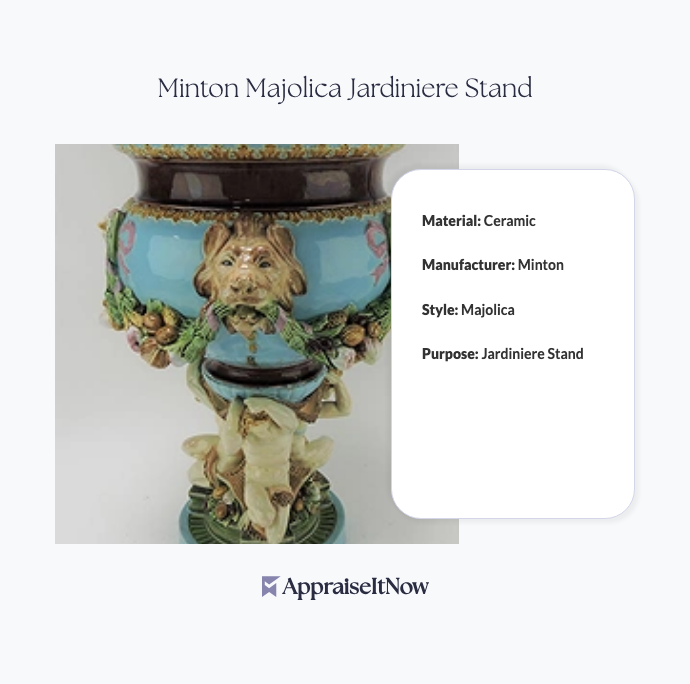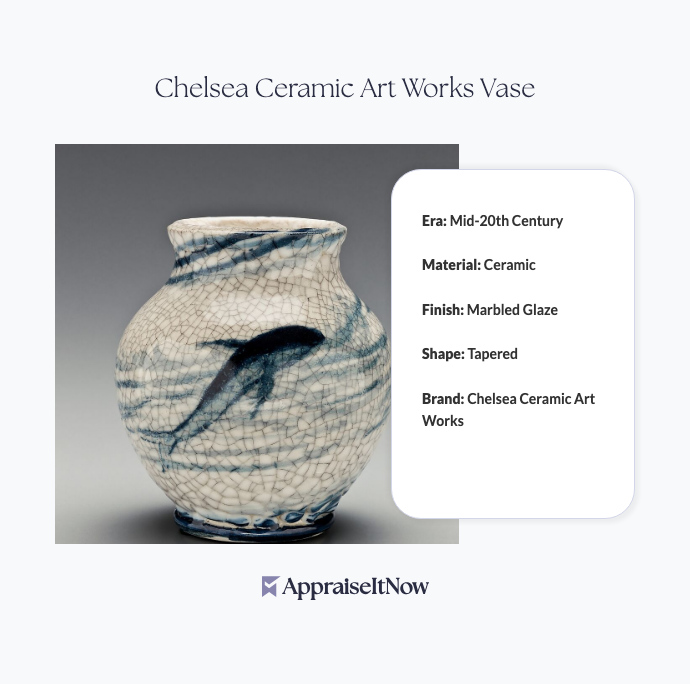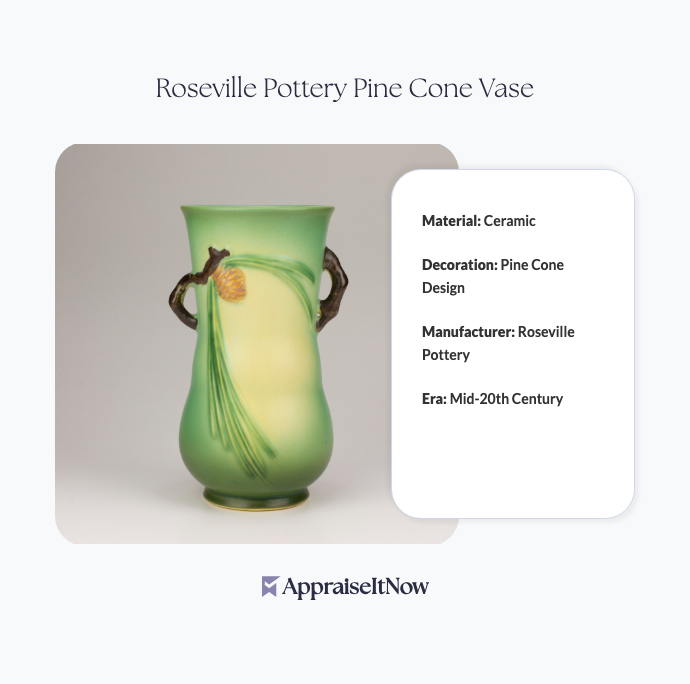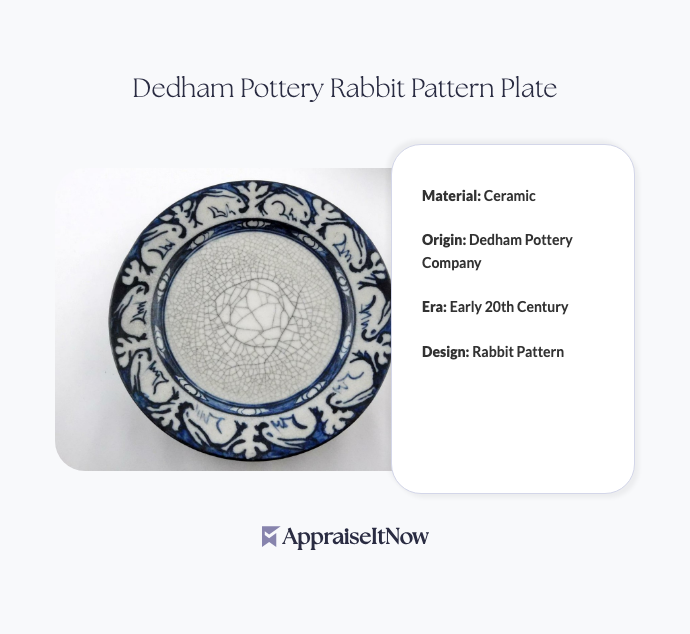<h1>How to Get Your Minton Majolica Jardiniere Stand Appraised</h1>
<p>If you've inherited or acquired a Minton Majolica jardiniere stand, you likely recognize its ornamental beauty and potential value. These Victorian-era ceramic pieces represent the pinnacle of British decorative arts, commanding estimated valuations between <strong>$3,000 and $5,000</strong> for quality examples. Understanding how to properly appraise your piece ensures accurate valuation for insurance, sale, or collection documentation purposes.</p>
<h2>Understanding Your Minton Majolica Jardiniere Stand</h2>
<p>The Minton jardiniere stand represents a unique convergence of functional design and artistic craftsmanship. First introduced in <strong>1845</strong>, Minton emerged as the leading British ceramics manufacturer, producing pieces that defined Victorian aesthetic sensibilities. Your stand likely displays the hallmark characteristics that distinguish Minton creations: vibrant glazed colors, intricate hand-painted designs, and the lustrous finishes that collectors worldwide pursue.</p>
<p>The jardiniere stand served a specific purpose in Victorian homes—displaying potted plants or flowers as both functional and decorative furniture pieces. Manufactured in <strong>Stoke-on-Trent</strong>, the heartland of English pottery production, Minton pieces incorporated premium materials and superior craftsmanship that set them apart from competitors. The popularity these stands enjoy in today's market stems directly from that historical excellence and the hand-applied artistry evident in each example.</p>
<div class="callout tip"><p><strong>Collector's Insight</strong></p>
<p>Minton pieces with original provenance documentation and clear maker's marks typically command premium valuations compared to unmarked examples.</p></div>
<h2>Key Features That Influence Minton Jardiniere Stand Value</h2>
<p>When determining your piece's worth, appraisers evaluate several specific factors. The quality of the hand-painted designs matters significantly—earlier pieces featuring more intricate, detailed artwork typically outperform those with simpler patterns. The color vibrancy also plays a crucial role, as pieces maintaining their original glaze brightness without fading or restoration indicate better condition and higher value.</p>
<p>The stand's structural integrity directly affects valuation. Check for chips, cracks, or previous repairs, as professional appraisers examine these details carefully. Original glazing without restoration commands substantially higher prices than pieces requiring ceramic restoration work. The overall dimensions and proportions also matter—larger, more commanding pieces with balanced proportions typically exceed smaller or oddly proportioned examples in market value.</p>
<p>Manufacturing variations exist within the Minton catalog, and identifying your specific pattern or model helps establish accurate comps for valuation. Some patterns became more collectible than others, with rarer designs commanding premiums. Documentation showing your piece's production date within the company's manufacturing timeline strengthens its appraisal value considerably.</p>
<h2>Identifying Authentic Minton Pieces and Majolica Characteristics</h2>
<p>Distinguishing genuine Minton majolica from contemporary reproductions or inferior manufacturers requires understanding what defines the category. Majolica itself refers to a ceramic tradition characterized by brightly colored, ornately modeled earthenware—quite different from porcelain despite surface similarities. The glazing technique creates distinctive depth and luminosity that machine-made reproductions struggle to replicate.</p>
<p>How can you tell if a piece is majolica? Authentic majolica displays several tell-tale markers. The hand-molded details show evidence of individual craftsmanship, with slight variations between pieces that mass production cannot achieve. Running your finger across the underside reveals texture from hand-finishing rather than smooth machine precision. Majolica pieces feel substantial and weighty due to earthenware construction, contrasting sharply with lighter porcelain alternatives.</p>
<p>Examining the glaze quality reveals the artistry involved. Minton majolica exhibits rich, varied color transitions where glazes meet, creating subtle gradations impossible with spray or dip glazing alone. The underglaze shows exposed earthenware clay in characteristic buff or terracotta tones rather than pure white bisque. Most importantly, genuine Minton pieces bear maker's marks identifying the manufacturer, typically impressed or painted on the base.</p>
<div class="callout note"><p><strong>Authentication Tip</strong></p>
<p>The 3 pull rule in ceramics helps distinguish hand-formed pieces from molds—authentic majolica shows subtle variations when comparing multiple examples, whereas reproduction pieces appear virtually identical.</p></div>
<h2>Is Majolica Pottery Valuable?</h2>
<p>The straightforward answer is yes, majolica pottery commands significant value in today's collecting market, particularly pieces from renowned manufacturers like Minton. The combination of historical significance, artistic merit, and scarcity creates strong demand among collectors and interior designers seeking authentic Victorian decorative arts. Understanding what makes majolica valuable helps contextualize your piece's worth within the broader <a href="/types/antiques">antiques</a> market.</p>
<p>Several factors contribute to majolica's sustained value appreciation. Authentic Victorian majolica has transitioned from everyday functional ware to recognized artistic achievement, drawing collector interest similar to fine <a href="/types/artwork">artwork</a> and <a href="/types/antique-furniture">antique furniture</a>. The manufacturing techniques required skilled artisans no longer widely available, making existing pieces increasingly irreplaceable. Supply constraints combined with growing international collector interest consistently push valuations upward.</p>
<p>Your jardiniere stand qualifies as quality majolica if it bears Minton attribution, incorporates hand-painted designs, and maintains original glazing. Professional appraisers specializing in <a href="/blog/appraisals-for-fine-porcelain-and-ceramics-valuing-delicate-artistry">antique pottery and ceramics</a> can definitively establish authentic majolica versus later reproductions, which significantly impacts valuation.</p>
<h2>Finding Comparable Sales and Market Data</h2>
<p>Establishing your Minton jardiniere stand's value requires examining comparable recent sales. Auction results provide transparent pricing data showing what similar pieces actually sold for in the current market. Reviewing past 12-24 months of sales from reputable auction houses like Christie's, Sotheby's, or specialized decorative arts auctioneers helps identify price patterns for your specific style and size category.</p>
<p>Online platforms including specialist dealers and auction result databases offer additional data points. However, you should approach online pricing with some caution—dealers' asking prices often exceed actual transaction values, while reserve failures at auction show pieces that failed to reach estimated value. Professional appraisers synthesize this data to establish fair market value reflecting what informed buyers would pay today.</p>
<p>The provenance of comparable pieces matters as much as their physical characteristics. A Minton jardiniere stand from a known estate or prestigious collection sale may have commanded premium pricing due to that history. Your piece without documented provenance likely appraises at values reflecting standard market conditions rather than the premium tier.</p>
<h2>When and Why to Seek Professional Appraisal</h2>
<p>Obtaining a professional appraisal provides benefits extending far beyond understanding current value. Insurance companies typically require certified appraisals before issuing coverage for decorative arts and antiques, protecting your financial interest if loss or damage occurs. If you're planning an estate distribution, accurate appraisals ensure equitable value assessment across multiple items and beneficiaries.</p>
<p>Professional appraisers bring expertise and objectivity that personal research cannot replicate. They understand regional market variations, recognize manufacturing details distinguishing premium pieces from ordinary examples, and access comparative sales data through specialized databases. For significant pieces like your Minton jardiniere stand, this expertise typically costs between <strong>$200-$500</strong> for detailed written appraisals, representing minimal investment compared to the potential financial implications of inaccurate valuation.</p>
<p>Appraisals from credentialed experts also provide legal standing should disputes arise regarding value during sales, insurance claims, or estate proceedings. Professional documentation demonstrates diligent effort to establish accurate valuation, protecting your interests in formal contexts where casual estimation carries insufficient weight.</p>
<h2>The Appraisal Process for Decorative Arts and Antiques</h2>
<p>Understanding what appraisers examine helps you present your piece effectively during evaluation. The process begins with visual inspection identifying maker's marks, manufacturing dates encoded in markings, and overall condition assessment. High-quality photography from multiple angles documents the piece's appearance for the appraisal report, particularly capturing decorative details and any imperfections.</p>
<p>Research into your specific pattern or model follows, with appraisers consulting factory records, pattern databases, and published references on Minton production. This research phase establishes whether your piece represents a common, widely-produced design or a scarcer example commanding premium value. Measuring the stand's dimensions provides context for size-based value variations within specific patterns.</p>
<p>Comparative analysis of recent comparable sales through auction databases and dealer networks establishes the market value range. Professional appraisers synthesizing this information produce a detailed written report including high-resolution photographs, condition description, historical context, and justified market value conclusion. This documentation provides insurance companies, potential buyers, or legal proceedings with credible valuation substantiation.</p>
<div class="callout tip"><p><strong>Preparation Tip</strong></p>
<p>Document any information you possess about your jardinière stand's acquisition history, previous ownership, or documented provenance before your appraisal appointment—this context helps appraisers establish more confident valuations.</p></div>
<h2>Beyond Simple Valuation: Understanding True Market Value</h2>
<p>Your Minton jardiniere stand's estimated value of <strong>$3,000 to $5,000</strong> represents fair market value—the price at which an informed buyer and seller would reasonably transact under normal market conditions. This differs from retail replacement value (what new reproduction pieces might cost), insurance replacement value (potentially higher), or forced liquidation value (potentially lower).</p>
<p>Understanding these value distinctions proves crucial when setting expectations for sales. If you sell privately, you might achieve valuations toward the higher end through patient marketing to serious collectors. Selling through auction houses incurs commissions reducing net proceeds, though auction exposure may attract competitive bidding driving prices upward. Dealer purchases typically occur at wholesale pricing significantly below appraised value, reflecting their acquisition costs and profit requirements.</p>
<p>Professional appraisers familiar with <a href="/types/antique-furniture">antique furniture</a> and decorative arts markets understand these distinctions and provide valuations reflecting realistic market transactions. Their expertise ensures your understanding of your piece's value aligns with actual market conditions rather than wishful thinking or artificially inflated estimates.</p>
<h2>Preserving Your Jardiniere Stand's Value</h2>
<p>Protecting your piece's condition directly protects its financial value. Majolica's glazed earthenware requires careful handling—avoid sudden temperature changes that stress the clay body, and store in stable environmental conditions around <strong>65-75 degrees Fahrenheit</strong> with moderate humidity preventing both excessive drying and moisture absorption.</p>
<p>Display your stand away from direct sunlight, which can fade the vibrant colors distinguishing valuable majolica from inferior examples. Dust carefully using soft brushes rather than cloths that might catch on decorative protrusions. Never attempt amateur restoration, as professional restoration costs and methods substantially impact value—preservation of original glazing and hand-painted details always exceeds the value gained through cosmetic repair attempts.</p>
<p>Understanding how majolica patterns and famous designs maintain value helps inform your collection and preservation decisions. The most sought-after Minton patterns—particularly nature-inspired designs featuring birds, flowers, or foliate elements—retain and appreciate value most consistently. Your jardiniere stand's specific pattern influences both current value and future appreciation potential.</p>
<h2>Minton Majolica in the Broader Collectibles Landscape</h2>
<p>Minton majolica occupies a distinct position within ceramic collectibles, commanding respect among serious collectors of <a href="/types/memorabilia-and-collectibles">memorabilia and collectibles</a>. Unlike some categories dependent on celebrity endorsement or temporary trends, majolica appreciation rests on genuine artistic merit and historical significance. The Victorian era's aesthetic achievements continue resonating with collectors seeking authentic decorative objects embodying craftsmanship and design excellence.</p>
<p>Comparing majolica valuation to other ceramic collectibles reveals its strong market position. While fine porcelain commands different value structures and contemporary ceramics pursue different aesthetic directions, majolica occupies the middle ground where historical significance, artistic achievement, and relative scarcity combine to support steady appreciation. This stability makes majolica a reliable investment category for collectors balancing aesthetic enjoyment with financial prudence.</p>
<p>Your Minton jardiniere stand represents genuine decorative art rather than passing collectible trend—a distinction that appraisers recognize when establishing valuations. This foundational quality supports both current market value and reasonable confidence in future appreciation prospects.</p>
<div class="callout note"><p><strong>Key Takeaway</strong></p>
<p>A certified appraisal of your Minton Majolica jardiniere stand provides accurate market valuation, professional documentation for insurance or sale purposes, and confidence that your understanding of this piece's worth aligns with realistic current market conditions. AppraiseItNow's credentialed appraisers specializing in decorative arts deliver USPAP-compliant valuations that serve your financial and planning needs effectively.</p></div>







.avif)







